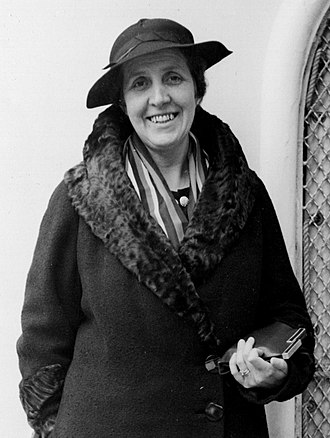Elizabeth Blegen

Elizabeth Denny Pierce Blegen (June 26, 1888 – September 21, 1966) was an American archeologist, educator and writer who contributed the quarterly report, “Newsletter from Athens” for the American Journal of Archaeology from 1925 to 1952.
Elizabeth Denny Pierce, known as ‘Libbie’, was born June 26, 1888 in Allegheny, Pennsylvania to Flora McKnight and William Lemmex Pierce. She attended Vassar College from 1906 to 1910, and in 1912 she obtained an MA in Latin.[1][3][4]
In her first year at Vassar, Pierce met Ida Thallon, who was to have a profound influence on her life and work. Thallon was a Professor in the Department of Greek and Roman Studies.[4] The two women formed an intimate student/mentor relationship that developed into an intimate personal relationship which continued after Pierce left for graduate work at Columbia University.[4] When Pierce returned to Vassar to teach art history in 1915, the couple started living in adjacent rooms in Davidson house on campus; their relationship at this time has been described as a ‘Boston marriage’.[5]
From 1915 until 1922, Pierce taught Art History at Vassar and worked as an assistant curator at Vassar’s Art Gallery.[1][3] She was granted her PhD from Columbia in 1922. Her dissertation as well as her Master’s thesis was on the intellectual life of Gaius Asinius Pollio, a Roman Consul (40 BC) and historian.[1] She travelled to Greece with Thallon in 1921. Her time in Greece inspired her to enroll in the American School of Classical Studies (ASCSA).
Pierce attended ASCSA from 1922 to 1923 where she became friends with the school’s director, Bert Hodge Hill, and archeologist Carl Blegen. Carl Blegen taught prehistory and general topography classes at the school.[3] Pierce and Blegen’s friendship quickly turned into romance and Blegen proposed marriage; Pierce initially accepted but then broke off the engagement as she did not wish to end her relationship with Thallon.[4][5] Pierce returned to the United States and spent the spring of 1924 working at the Metropolitan Museum of Art.[3] Meanwhile, a plan was formed by Blegen, Pierce, and Hodge Hill (who appears to have had unreciprocated romantic feelings for Blegen) that Hodge Hill and Thallon would marry at the same time as Pierce and Blegen, and the four would live together; Thallon agreed on condition that she and Pierce would continue to travel and spend time together away from their husbands, and the two couples married in 1924.[4][5]
The four archeologists, who referred to themselves as “the Family”, “the quartet”, and “the Pro Par” (short for “Professional Partnership”), had a strong and interconnected relationship both professionally and personally.[5] Thallon Hill and Pierce Blegen often worked together on excavations, cataloguing materials and publishing findings from excavations run by both their husbands.[6][3] During her first year of marriage, Pierce Blegen taught sculpture classes at ASCS. One of her first projects with Thallon Hill was assisting her in the cataloguing of new finds from the excavation of Corinth, in collaboration with Elizabeth Van Buren, a specialist in terracottas.[6] Pierce Blegen, along with Thallon Hill, participated in Carl Blegen’s excavations at Prosymna (1927–1928), where she studied the finds of jewellery;[7] Troy (1932–1938) and Pylos (1939, 1952–1958); the two also worked with Hodge Hill in Cyprus.[1]
Elizabeth Pierce Blegen in the 1930s
Beginning in 1925 and continuing until 1952, Pierce Blegen authored the “Newsletter from Athens”, a regular contribution to the American Journal of Archaeology. In the personal correspondence of archeologist Lucy Shoe Merritt (May 4, 1997) she described Blegen’s newsletter: “Her reports were the results of close, careful understanding, first-hand observation and discussion with the excavators whom she grew to know so well and who admired and trusted her with their latest discoveries and thoughts about them (the excavations).[1]
